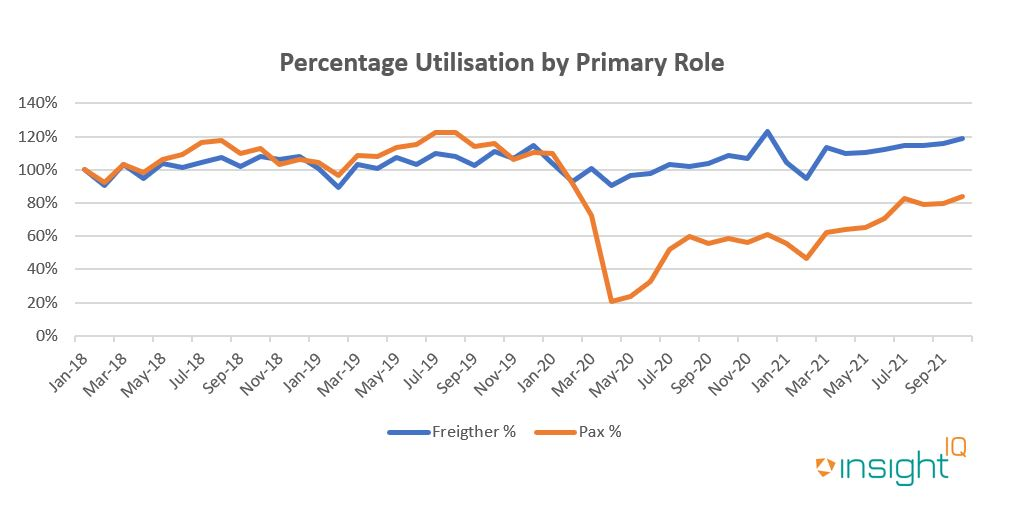18/11/2021
Utilisation of freighter aircraft engines is leading over passenger, but such comparisons should be viewed in context, writes David Archer.
There are several clear divides in the recovery of the aircraft engine market. Distinct differences can be seen when comparing new generation versus mature engines, as well as those utilised by widebody and narrowbody aircraft. A similarly important comparison can be made between engines fitted to passenger and freighter aircraft.
Overall, freighter operating numbers are far below that of passenger aircraft, and any such comparison should be performed on relative terms.
Data from InsightIQ highlights performance throughout the pandemic, grouped by the primary role of aircraft, passenger or freighter. It is notable that in October 2021 the monthly utilisation was 137,409 hours for freighters vs 2,167,553 hours for passengers.

At the softest point, passenger aircraft utilisation fell to 21% compared to January 2018 levels, while freighter utilisation dipped to 91% (having previously fallen to 90% in February 2019). Both markets have seen recovery since, though the rise of e-commerce demand has meant the freighter market has seen utilisation rise to around 20% above average. Passenger operations remain 15-20% below. As highlighted in the chart above, both markets are affected by natural cyclical patterns and a down turn should be expected in early 2022.
There are further nuances within each market, such as engines falling in and out of favour with their respective operator bases. The chart above shows the breakdown of market share by flight numbers for the most popular freighter engine type. The net result in the freighter market can be seen below.

The winners in the freighter market have largely been the mature widebodies, with the CF6, PW4000 and RB211 representing a strong market share given the age of these platforms. GE90 growth in this sector is promising for the type which has struggled in the passenger market. Given that there is largely a limited supply of mature engines in good condition and demand is at a peak, IBA has witnessed values and lease rates continue to climb through the pandemic. This trend will inevitably balance out in the mid-term, but for now is set to continue through the Christmas period with high demand.
Passenger operations have been a little softer, with the main trend being strong growth in the LEAP and GTF markets. Overall the trend has been negative for the fleet, however CFM56 and V2500 operations continue to climb beginning to push value back into a healthier state. Mature widebodies are continuing to be forced out of this space and whilst some will return there is increasing pressure to convert to freighter where viable.

Overall the market is moving in a positive direction, but considering current market availability of many of these engines, there is still some way to go before values return to healthy levels. The market share of new generation narrowbody engines continues to grow, and the scale of the CFM56 and V2500 fleets give these engines a long future. Negative pressures have focused on mature examples which will see pressure for part out, whilst widebody aircraft continue to lag behind, forcing a softer market for these engines.
IBA's InsightIQ analysis platform flexibly illustrates multiple asset, fleet and market positions, actual and potential, to inform client choices and identify acquisition opportunities. Immediate access to crucial aircraft, engine, lease rate and fleet data eases appreciation of historic and future aircraft concentrations and operator profiles.
相关内容
IBA has reviewed and updated our forecasts for narrowbody aircraft trends in October 2021.
IBA has reviewed and updated our forecasts for widebody aircraft engine trends in October 2021.